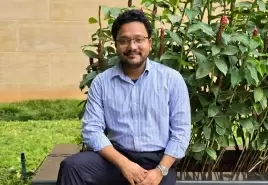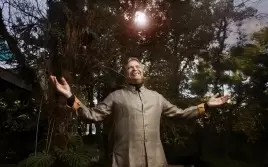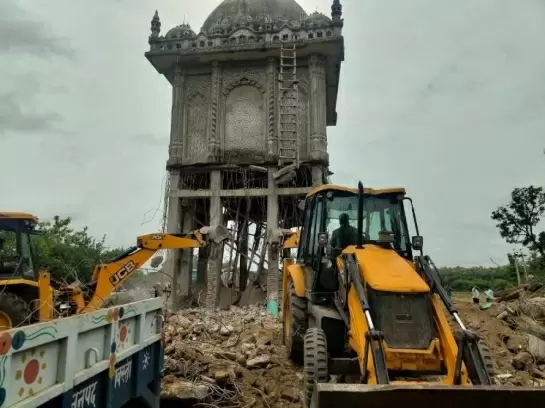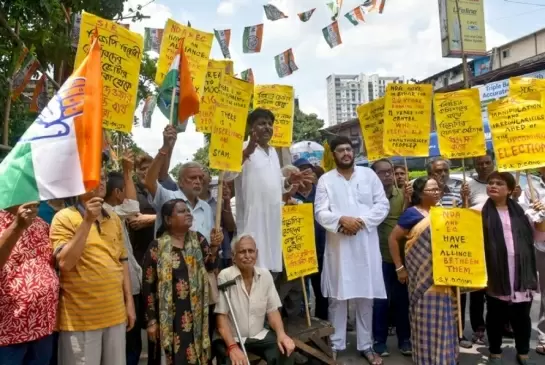From a malnourished and unwashed lot, they turned prosperous because one man had a will
26-January-2012
Vol 3 | Issue 4
Text: Anita Pratap Photos: Mahesh Bhat
The broken bund (mud embankment) was emblematic of all that was wrong with Laporia. The inhabitants of this arid village in an arid district in India’s most arid state, Rajasthan, were dirt poor.
They were malnourished, wore torn clothes and rarely washed. Soap, they could not afford. Nor sugar or milk in their tea. Many went to bed hungry every night. Diseases and illnesses went untreated, because there were no medicines. Children remained illiterate. Cattle died of thirst.
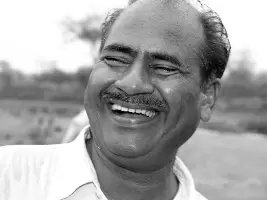 |
|
Laxman Singh transformed his once arid village into a fertile place
|
The root cause of Laporia’s misery was acute water scarcity.
Farming was the main occupation for the 200 families. But drought, compounded by the crumbling bund, dry ponds and empty wells doomed cultivation to a perennial losing battle with nature, city jobs became the sole meal ticket.
Laxman Singh went to Jaipur to study, but dropped out of school because his family could not afford the fees. Miserable, he returned to the misery of his village. He faced a bleak future. No education meant no jobs in the city; no water meant no farming in his village.
Laxman Singh was 18 years old when he realized the only way to turn Laporia’s misfortune was to repair the bund along the dry pond. It had remained broken for 30years. If scanty rainfall could be collected in the pond, then feeder canals could be dug to irrigate the fields, making cultivation feasible.
Laporia could turn “green”. Villagers mocked his fantasy. “And who would pay our wages to repair the bund?” they demanded sarcastically. Laxman Singh had no answer. He was stumped: no rich landlords to subsidize the labour; no philanthropists nearby to fund and the government was far away and unconcerned. He was thoroughly depressed. There seemed no way out of this vicious cycle.
Then one day it struck him perhaps there is a way out: villagers could volunteer to repair the bund. After all, they were the beneficiaries. Neighbors scoffed at his suggestion. They had better things to do.
Singh resolved to do it himself. One friend supported him. The pair decided to repair the bund themselves. It was no small task: the bund was 1.5Km long and 15 feet high. Armed with spades, they set off to the bund one summer day in 1978.
Passersby wondered; “How can the bund be repaired by just two people?” Singh retorted “well, you can join us, that would help.” Four village youth joined him. By the seventh day, the trickle swelled to 20. When rains came two months later, water collected in the pond for the first time in decades.
By 1984, the pond was irrigating 1,800 acres of farmland. From virtually no income, the average income of a family rose to Rs.14,000 per annum – enough to provide a comfortable life.
Villagers congregated for the ceremony to name the pond “Anna Sagar”: the sea of grain. Asserts Singh, “If you really want to achieve anything in life, you have to get down and do it yourself. You can lead others only by setting yourself as an example.”
Laxman Singh also devised a simple but unique water harvesting program in the outskirts of his village. He call it’s the “Chauka” system. It comprises a series of channels and square pits fringed by two-foot high bunds in a chequer board pattern over a 5Km expanse in which rainwater collects and meanders down the natural slope of the land.
This not only enables the water to flow into the ponds nearby, but creates grassy patches on the pits on which cattle can graze. Thus, his dry wastelands bordering the villages were converted into grassy village common land, ideal for pasture.
Villages die when common land disappear. Called “gochar”, pasture is considered sacred by Hindu villagers. Across India, pasture for cattle grazing is vanishing, either due to drought or to land grabbers. Grassy gochar symbolizes healthy villages. It symbolizes the symbiotic relationship between man, nature and animals.
If water is harvested, crops and grass grow and cattle have natural vegetation to feed on, which is cheaper and healthier than hormone-injected cattle feed. More cattle mean more dung, which is the cheapest and best natural fertilizer-cum-pesticide. Organic farming – which now the world acknowledges – is the healthy, natural way to cultivate crops.
No pesticides and fertilizers that poison the earth and drive farmers to penury, says Laxman Singh. “The less we interfere with nature, the better it is for all of us. Everything and everyone has its place in our eco-system. We live in a natural cycle of inter-dependence – land, water, man, beast, all depend on each. If you don’t disrupt the cycle of dependency, this natural bio-rhythm, there will be harmony.”
Over the years, all the ponds of the village were rejuvenated. Villagers performed puja to celebrate the consecration of “Dev Sagar” and “Phool Sagar.” Crops were harvested twice a year. Laporia became virtually self sufficient as farmers grew corn, maize, bajra, jowar, wheat, lentils, groundnuts, chillis, mustard, fenugreek and variety of vegetables.
Their new-found sense of well-being made villagers feel the need to organize a thanksgiving ceremony. In 1987, the villagers institutionalized their annual nature-worshipping ritual.
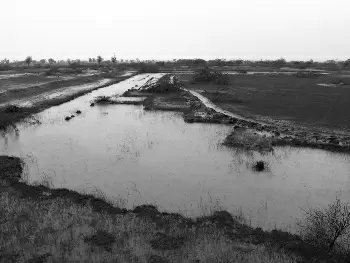 |
|
Lakshman Singh and his friends in Laporia used 'Chauk' method of ground water recharging. A series of bunds, channels and pits are dug over a 5Km stretch in a checker board like pattern, following the natural slope of land. Rain water flows slowly across the Chauka system resulting in the retention of top soil and increase in moisture content. This also helps in recharging ground water
|
Villagers gather to renew their bond with nature and each other, eat gud (melted jaggery), tie sacred threads and apply tilak on trees, birds, cattle, wells and ponds. They pray to Lord Indra to bless the village with rain. They tie rakhi on each other as mark of friendship and community bonding. It is day of festivity and rejoicing.
From an impoverished, drought-afflicted, conflict-ridden village, Laporia become a trail-blazing symbol of rural renewal, a self-sufficient oasis of agricultural produce, peace and harmony.
Its fame spread. Other adjoining villages followed suit. Villagers started organizing the “Shram Dhan”, to donate their labour to desilt the tanks and ponds. The desilting ceremony takes about five days.
Over the years, this became a vibrant local tradition. Inhabitants of Laporia went on a padayatra to the adjoining villages to help with the desilting of their ponds. These villagers came to theirs. Now 500 villages participate in these padayatras to desilt their water bodies.
In the evening, youngsters organize cultural entertainment – songs, dances and street theatre. The evening ends with a sumptuous feast prepared by the village housewives. Says Singh: “As businessmen and officers, my classmates make more money than me. But I have the satisfaction of changing the life of my entire village.”
Village development committees now decide on new programs to build roads, install taps, establish health and education facilities. Self-sufficiency is the village mantra; Panchayati Raj as Mahatma Gandhi envisioned.
“Villagers must be encouraged to become custodians of their village and its surroundings. If every village becomes a viable, harmonious and peaceful economic unit, then people would be happy and India would be strong.
“When village life breaks down, and youngsters are forced to migrate in search of work, then villages starve and cities bloat. Both will die. It's not sustainable,” predicts Singh, who has never heard of the pro-environment Norwegian Prime Minister, Gro Harlem Brundtland, who coined the phrase “Sustainable Development” in the 1980s.
Singh, typifies the Indian villager, who blessed with robust common sense, needs no celebrity endorsements or academic studies, to convince him of the ancient wisdom that he carries in his genes, refreshed everyday by observing nature.
One would have expected Singh to be rewarded with a bouquet of citations for path-breaking work. Instead, village officials were displeased. They served him with a ‘show cause’ notice for usurping their authority.
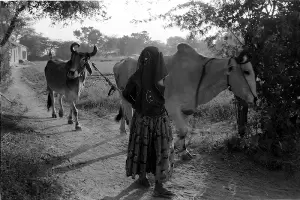 |
Laxman Singh had framed new rules for his village. If a villager cut a tree, he would have to plant five saplings as compensation. If he hunted animals, he must pay a fine of 11 bushels of grain. If he shot a bird, he would have to feed the village birds.
Most complied; some complained. Local officials were annoyed. Punishing villagers was their job, not his. Laxman Singh was summoned to their office, but his entreaties and explanations that patwaris ignored such offences or took bribes from the offenders and released them, fell on deaf ears.
When he heard about this harassment, a botanist from Jaipur, who had taken an interest in Laporia’s transformation, contacted Delhi-based scientists, who in turn urged village officials to lay off Laxman Singh. They did. Slowly, brickbats turned to bouquets as the authorities began to reward him with prizes for his pioneering work to rejuvenate Laporia.
Perhaps, the most remarkable aspect about Laporia’s renewal is its forestation that has lured birds. Says Laxman Singh proudly: “Birds are the best signs of a healthy environment.”
Varieties of birds now flock to Laporia. The village courtyard is a daily Kumbh mela of parrots. Peacocks perch on roof tops. Woodpeckers hug tress. Pigeons strut. Koels coo hauntingly. People of this once arid, godforsaken village greet each day with the birdsong of larks, warblers, nightingales and other winged minstrels of the forests.
(Extract from the book ‘Unsung’ by Anita Pratap and Mahesh Bhat)



